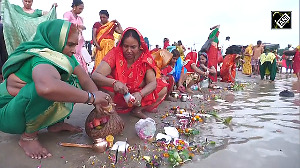The fact remains that in the present-day Tamil Nadu, GenX and GenY voters, born and/or growing up after the end of ‘Kamaraj rule’ in the ’60s and ‘MGR rule’, respectively, constitute an absolute majority of the electorate.
If they still vote for a Rajini or Kamal, in preference to the established ‘Dravidian voters’, it is despite the MGR imagery, not because of it, says N Sathiya Moorthy.

Breaking his political near-silence of three months since announcing an intent to enter the electoral game, Tamil filmdom’s ‘superstar’ Rajinikanth has now promised to ‘provide MGR rule’ to the state.
In the same vein, he also showered some praise on MGR’s political heir, the late AIADMK Chief Minister Jayalalithaa, both clearly indicating that he was targeting the ruling AIADMK cadres, in the absence of a strong and charismatic leader to call its own.
But the electoral calculations of Rajini’s set of advisors, to whom he has otherwise made a reference in his latest public speech, may go awry if the Tamil Nadu voters behave the way they had done on earlier occasions, especially vis-à-vis similar calls for giving ‘good governance’ in the name of leaders past.
Before Rajini now, Desiya Murpokku Dravida Kazhaam’s actor-founder Vijayakanth commenced his politico-electoral journey, promising ‘MGR rule’ when he took courage to launch a new political outfit on the eve of the 2006 assembly elections in ‘Dravidian’ Tamil Nadu.
In his very first electoral outing, Vijaykanth got a respectable and results-threatening 8.6 per cent vote-share, though he was his party’s lone winner in the 234-seat assembly.
In the parliamentary polls of 2009, which again he was bold enough to contest on his own without any party or prime ministerial candidate to call his own, his party improved the vote-share to 10.5 per cent -- but no seat from 40, including Puducherry.
Electoral calculations showed that the Vijayakanth PR machinery’s depiction of the actor-politician as ‘karuppu MGR’, or ‘dark-skinned MGR’ had gone down well with a section of old-generation AIADMK cadres of the time.
That was all to it. Come the even more polarised assembly polls of 2011, the DMDK exposed its lack of ‘staying power’, especially with apprehensions that the ‘MGR votes’ were returning to Jaya-led AIADMK, which was expected to win at the time.
Better still, between Vijayakanth’s arrival and his inevitable decision to align with the AIADMK in 2011, lest he should lose those votes as well, Jaya had begun swearing all over again by MGR, after forgetting her mentor and party founder for a time.
The DMDK’s decision showed that in Tamil Nadu, ‘staying power’ also mattered -- rather, it mattered the most.
Today, the DMDK is a poor self of its original, grossing around three per cent vote-share, if either the new stars in the political horizon, like Rajini or Kamal Hassan, or other established parties do not take some or all of it away.
Before Vijayakanth and the DMDK, the late G K Moopanar, under the national Congress leadership of Rajiv Gandhi, sought a ‘mandate’ for the party in the post-MGR 1989 assembly polls to restore ‘Kamaraj rule’ after two decades of ‘competitive Dravidian misrule’.
In the year-long run-up to the elections, Rajiv Gandhi toured the nook and crony of the state 11 times in 12 months or thereabouts, and received massive crowds.
The results, however, were disappointing. The DMK under Karunanidhi returned to rule the state after 13 years of ‘vanvas’ when MGR was around and reigning supreme. The post-MGR Jayalalithaa faction of the AIADMK came a distant second with 21 per cent vote-share and 29 seats. The Congress, which still retained a respectable 20 per cent vote-share, came a poor third, with 27 seats.
Internal analyses later reportedly showed that the GenX voters of the day, who may have wanted change, did not even know what ‘Kamaraj rule’ was all about, to make any comparison with the ‘Dravidian misrule’.
If anything, the first-time voters did not know even what the DMK or Karunanidhi-led ‘mis-rule’ was, the two having lost power as far back 1976, for which they blamed the Emergency era.
It is another matter that the Congress, which went on to align with the AIADMK under Jayalalithaa for the ensuing 1991 elections to the Lok Sabha and the state assembly, could not stabilise and strengthen itself on the clean sweep that they together made, mostly on the strength of the ‘sympathy wave’ generated by the intervening ‘Rajiv Gandhi assassination’.
It did not stop there, either. In the subsequent 1996 twin polls in the state, the DMK returned to power, almost literally on the shoulders of the ‘credibility card’ attaching to the Congress’s breakaway faction TMC, founded by Moopanar, the ‘Mr Clean’ of Tamil Nadu politics of the time.
Yet, when the TMC and Moopanar decided to go it alone in the subsequent Lok Sabha polls of 1999, when the DMK ally from 1996 and 1998 decided to pitch tent with the ‘communal’ BJP at the national level, the TMC, along with its Dalit electoral allies, could not muster more than 10 per cent vote-share.
The TMC share itself could be put at less than five per cent, while the Congress parent, contesting alone in 1998, had polled 4.5 per cent, thus adding up to a ‘Congress pool’ of less than 10 per cent vote-share, down from double that figure only a decade earlier, in 1989.
Against this, in the twin LS polls of 1998 and 1999, the Vajpayee-Advani leadership of BJP had brought in an inexplicable 6-7 per cent extra vote-share to the AIADMK and DMK alliance, of which it was respectively a junior partner.
The BJP would soon return to its usual 2-3 per cent vote-share without the ‘Vajpayee-Advani’ halo, to rise again, in the 2016 assembly polls, after the ‘Modi magic’ had brought in a similar five per cent extra vote-share to the NDA combine, yet coming a poor third in vote-share but bagging two LS seas in aggregate.
If all of these were to show the ‘non-Dravidian’ vote-share in Tamil Nadu over the past decades, the question remains if the new, GenY voters, especially born or growing up in the post-MGR era, could assimilate the sum and substance of ‘MGR rule’ that Rajini now promises to bring back?
The fact remains that in the present-day Tamil Nadu, GenX and GenY voters, born and/or growing up after the end of ‘Kamaraj rule’ in the ’60s and ‘MGR rule’, respectively, constitute an absolute majority of the electorate.
If they still vote for a Rajini or Kamal, in preference to the established ‘Dravidian voters’, it is despite the MGR imagery, not because of it. Some of them may even have problems identifying with a political party or leader seeking to identify with MGR or Jayalalithaa or Karunanidhi (whom again Rajini referred to in his speech) when he himself wants to change all that those imageries represent now.
Rajini too half-seriously referred to the contradiction while unveiling an MGR statue at the ‘MGR University’, a private institution being run by another had-been politico in A C Shanmugham, founder of the New Justice Party, which had failed to take off. He said that if he mentioned bringing back ‘MGR rule’, they would dub he was wooing the ‘AIADMK voters’.
Whether he admits it or not, that is the truth, or at least the perceived truth. In politics perceptions do matter, and it is on such perceptions of voters that both Rajini and Kamal are betting their electoral fortunes.
Already, AIADMK’s irascible minister, D Jayakumar, has begun hitting out at Rajini. Even as other critics have pointed out on social media how long stretches of the footpath on either side of the road leading up to the suburban university campus were blocked by huge flex banners, welcoming the ‘super-star politician’, Jayakumar has pointed to what he perceives as ‘contradictions’ in the latter’s pronouncements at the function.
One pertains to Rajini addressing students and talking politics to them, and yet asking them not to join politics but focus on their studies. Another is about Rajini asking students to learn English, an indirect hit, Jayakumar and the likes claim, at Tamil.
While the AIADMK especially cannot talk about the organisers violating the Madras high court’s ban on putting up such flex boards, blocking traffic and endangering lives, others also point to the credibility of the organisers of the function.
One, Shanmugam’s ‘New Justice Party’ was a caste-based party, centred on the upper caste Mudaliar community in the northern districts, which used to be identified mainly with the Justice Party in its time, and more so with the DMK, when founded. By naming his outfit the ‘New Justice Party’, it was argued even then, that Shanmugam was not exactly talking about the ‘social justice’ plank of the original, or the latter-day Periyar-led self-respect movement and their political offspring, DMK, but only harking back to the former’s ‘Mudaliar’ links.
This apart, the last time Shanmugham and his institutions were in the news, it was at the height of the 2005 floods, when fishing boats were used to transport people on Mount Road and other main thoroughfare in the city.
At the end of it all, the then AIADMK government under Jayalalithaa ordered the demolition of parts of Shanmugham’s campus, when it was found that they had been built on government land and without permission or permits, and had blocked flowing flood waters and inundating housing complexes and slums nearby.
The social media is thus rife with questions if this is the kind of politics that Rajini intends taking forward, or is it the kind of political company that he wants to keep.
There is a subtext to his Monday evening function. As is known, Rajini was only one of the film stars, and more certainly the most popular of them all, on the dais.
It was possible that not all of them, or any of them, shared his political views. Hence, the question is now being asked if it was proper for Rajini to have used such a stage to air what were essentially his own personal views on politics and the political establishment of the day.
It is another matter that none of them thus far has come out to contradict Rajini, or his using a student crowd to air his own views, when some of them are known to have their own views but with little or no chance to contradict him on the dais.
With Rajini’s Kaala ready to hit the screens on April 27 his film distributors and possibly fans too are not sure how his reiterated political ambitions, goals and attacks on the ruling party would reflect on the ground.
According to them, if nothing else, the rulers of the day may not want to miss out on ‘exposing’ the ‘superstar’ when Kaala hits the screen and there is a mad rush for tickets in the black market.
The same could happen when the mega budget 2.0, the second part of multi-lingual Robot that hits the screen later, to be followed by a new film that he has since announced, in the company of Sun Pictures of the Sun TV group.
Black-marketing in film-tickets apart, already social media is rife with questions as to why Rajini, who was wanting to become chief minister asap, has not said anything about the ‘Cauvery water dispute’ even in his first public speech on Monday -- when it was a burning issue.
The implicit reference is to Rajini’s Karnakata nativity, and the state being the unyielding upper riparian state even after the Supreme Court, in its ‘final’ verdict, had directed the Centre to set up the Cauvery Monitoring Board.
N Sathiya Moorthy, veteran journalist and political analyst, is director, Observer Research Foundation, Chennai Chapter.










